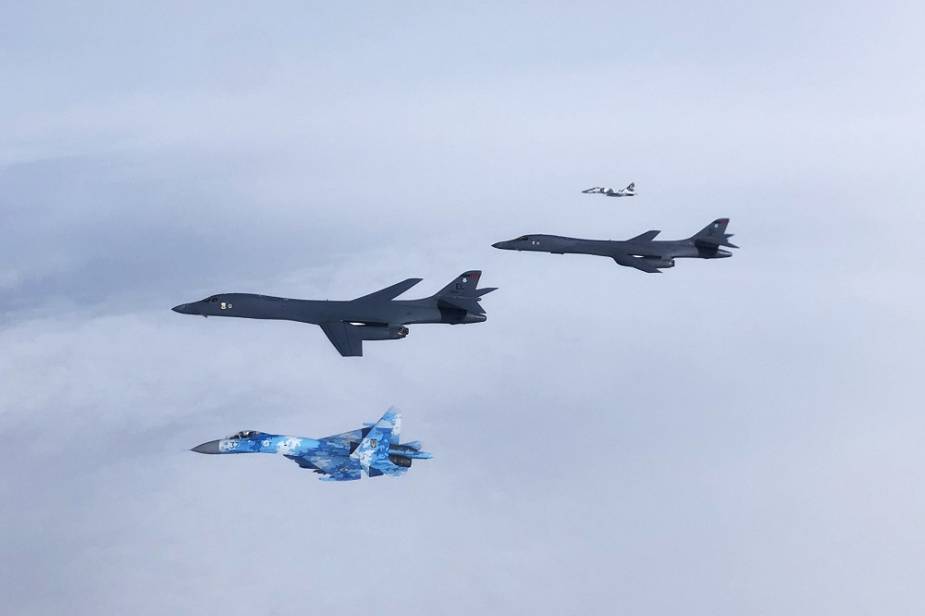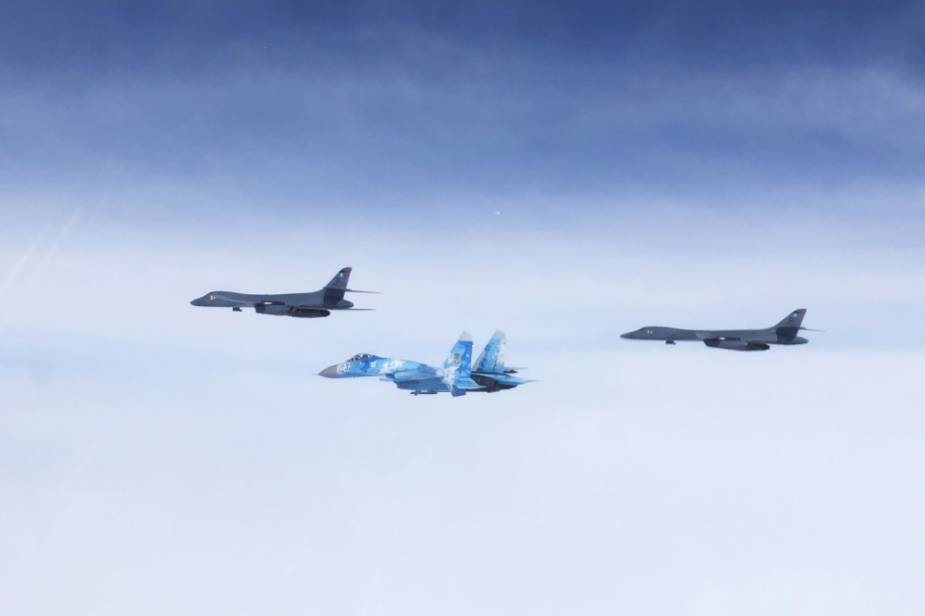Two B-1B Lancers from Ellsworth U.S. Air Force Base, South Dakota, conducted a long-range, long duration strategic Bomber Task Force mission throughout Europe and the Black Sea region, May 29, 2020. Information released on the United States DoD (Department of Defense) media information website. This marked the first time that a Bomber Task Force mission integrated with Ukrainian Su-27 Flankers and MiG-29 Fulcrums and Turkish KC-135s.
Follow Air Recognition on Google News at this link
 A Ukrainian Su-27 Flanker and MiG-29 Fulcrum escort two B1B Lancers during a training mission for Bomber Task Force Europe, May 29, 2020. (Picture source Ukrainian Air Force)
A Ukrainian Su-27 Flanker and MiG-29 Fulcrum escort two B1B Lancers during a training mission for Bomber Task Force Europe, May 29, 2020. (Picture source Ukrainian Air Force)
The flight also included integration and interoperability training with Polish F-16s and MiG-29s and Romanian F-16s and MiG-21s, which provided escort and combat patrol overwatch in the Black Sea region.
A KC-135 Stratotanker from the 100th Air Refueling Wing, RAF Mildenhall, England, Turkish and U.S. KC-135s based out of Incirlik Air Base, Turkey, and other NATO aerial refueling aircraft enabled the B-1 to complete the round trip from Ellsworth Air Force Base without delay, while also providing aerial refueling support to our partner-nation aircraft.
Additionally, the B-1s integrated with Greek F-16 air policing for an overflight of Skopje, North Macedonia.
Bomber missions familiarize aircrew with air bases, airspace, and operations in different geographic combatant commands. These missions build proficiency and confidence, and they demonstrate the credibility of our forces to address a global security environment that is more diverse and uncertain than at any other time in our history.
The Rockwell B-1 Lancer is a supersonic variable-sweep wing, heavy bomber used by the United States Air Force. It is commonly called the "Bone" (from "B-One"). It is one of three strategic bombers in the U.S. Air Force fleet as of 2020, the other two being the B-2 Spirit and the B-52 Stratofortress.
The B-1A was initially developed in the 1970s as a replacement for the B-52. Four prototypes of this long-range, high speed (Mach 2.2) strategic bomber were developed and tested in the mid-1970s, but the program was canceled in 1977 before going into production. Flight testing continued through 1981.
The B-1B is an improved variant initiated by the Reagan administration in 1981. Major changes included and additional structure to increase payload by 74,000 pounds, an improved radar and reduction of the radar cross section by an order of magnitude. The inlet was extensively modified as part of this RCS reduction, necessitating a reduction in maximum speed to Mach 1.2.
The first production B-1 flew in October 1984, and the first B-1B was delivered to Dyess Air Force Base, Texas, in June 1985. Initial operational capability was achieved on Oct. 1, 1986. The final B-1B was delivered May 2, 1988.

A Ukrainian Su-27 Flanker escorts two B1B Lancers during a training mission for Bomber Task Force Europe, May 29, 2020. (Picture source Ukrainian force)
The Sukhoi Su-27 (NATO reporting name: Flanker) is a Soviet-made twin-engine fighter aircraft designed by the Russian company Sukhoi. The Su-27 entered service with the Russian Air Force in 1985.
The Su-27 is armed with a single 30 mm Gryazev-Shipunov GSh-30-1 cannon in the starboard wingroot, and has up to 10 hardpoints for missiles and other weapons. Its standard missile armament for air-to-air combat is a mixe of Vympel R-73 (AA-11 Archer), Vympel R-27 (AA-10 'Alamo') weapons, the latter including extended range and IR guided models. More advanced Flanker variants (such as Su-30, -35, -37) may also carry Vympel R-77 (AA-12 Adder) missiles. Armament for air-to-ground missions include: 100kg, 250kg and 500kg freefall and retarded aerial bombs; 500kg incendiary devices; 25kg and 500kg RBK cluster bombs; and C-8, C-13 and C-25 unguided aerial missiles.
The Mikoyan MiG-29 (NATO name Fulcrum) is a fourth-generation jet fighter aircraft designed and manufactured in Russia. Developed in the 1970s by the Mikoyan design bureau, it entered service with the Russian Air Force in 1983, and remains in use by the Russian Air Force as well as in many other nations.
Armament for the MiG-29 includes a single GSh-30-1 30 mm cannon in the port wing root. Three pylons are provided under each wing (four in some variants), for a total of six (or eight). The inboard pylons can carry either a 1,150 liter (300 US gal) fuel tank, one Vympel R-27 (AA-10 "Alamo") medium-range air-to-air missile, or unguided bombs or rockets. Some Soviet aircraft could carry a single nuclear bomb on the port inboard station. The outer pylons usually carry R-73 (AA-11 "Archer") dogfight air to air missiles, although some users still retain the older R-60 (AA-8 "Aphid"). A single 1,500-litre (400 US gal) tank can be fitted to the centerline, between the engines.
















